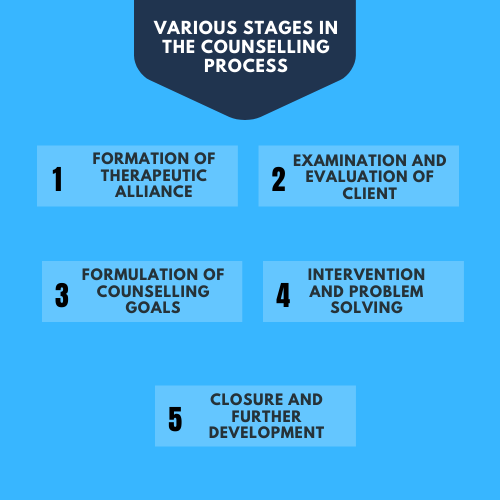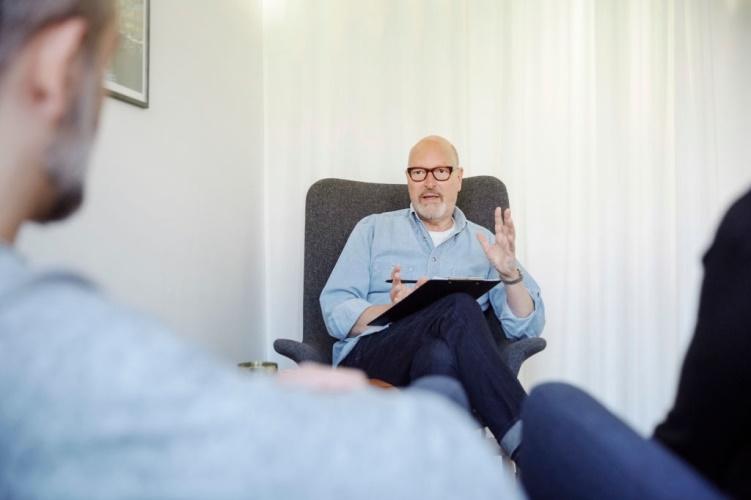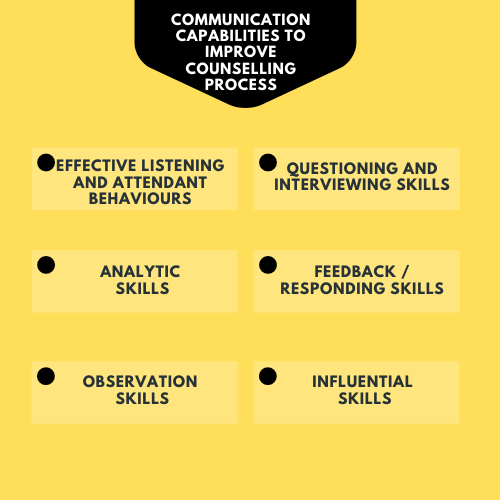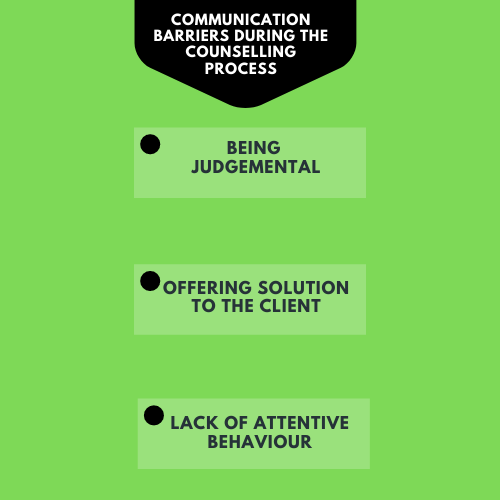Different Stages Of Counselling Process
Question
Task: Outline the Stages of Counselling Process in Psychology
Answer
Introduction
Counselling is the approach through which a practitioner provides advice and support to overcome mental, social and emotional issues (Pickard & Carroll, 2015). The psychological counselling that the psychologist gives to the patient includes relationship counselling, cognitive behavioural therapy, and psychiatry, as stated by McLeod (2013). The client can express the challenging thoughts to the counsellor, and the counsellor can assist the client in exploring their own solutions to these issues. The article will describe the key Stages of Counselling Process, including the development of relationships, the identification of issues, the development of appraisal objectives, issue resolutions, follow-up, and completion. The article also addresses the interaction skills needed during therapy which involves: listening skills, abilities to inquire, abilities to answer, abilities to interpret, abilities to evaluate, which skills to influence, etc. The essay also addressed the interaction obstacles during therapy that involve being condescending, offering remedies and absence of attendant behaviours.

Discussion
The stages of counselling can be divided into 5 elements, which are:

Formation of a therapeutic alliance
By creating a bond with the patient, the counsellor should begin the therapy phase (Moss, Gibson, & Dollarhide, 2014). In order to establish a relationship with the patient, the counsellor has many activities to perform. The task involves expressing their position as their patient's counsellor. As per (Jacobs, 2017), active consent will be sought when forming a partnership with the patient as the patient must recognize the whole therapy process and give approval to it. As per Moss, Gibson, & Dollarhide, (2014), the key requirement is that the counsellor should also announce themselves to the patient by real identities and should also call the patient by their names.

Examination and Evaluation
The second stage of the counselling process is evaluation and examination. The evaluation and examination phase, as per Nelson-Jones, would be when the psychologist collects the patient's details in an attempt to comprehend his / her condition and the explanations for pursuing the therapy. Instead of declaring for them, the counsellor should assist the client in articulating their issues. Moss, Gibson, & Dollarhide (2014) believes that the client's therapy concerns can be divided into multiple divisions that involve stress factors that are stressful occurrences which really trigger discomfort and anxiety to an individual. The second issue could be a requirement where anything that is very important for life and thus becomes disrupted may be absent from the patient. The third issue could be living environments that are the circumstances that are outside of the client's grasp that restrict his wellbeing attainment. The fourth problem may be unstable social dynamics, wherein the patient encounters difficulties with certain individuals but gets along with other individuals well.
Furthermore, the counsellor must take a glance forward to knowing the client's concern in order to set the appropriate targets and measures to mitigate the client issue. Moss, Gibson, & Dollarhide, (2014) suggests that relationship-based, behavioural-based, environment-based, affection-based and thinking-based can be the source of client issues pursuing guidance. In order to identify certain indications of an embodiment of their issues, the counsellor should be attentive to the patient. The client exposes their issues via concerns, anxiety, emotions, and, among many others, unfulfilling personal relationships.
Formulation of Counselling Goals
Preparation of objectives is one of the essential Stages of Counselling Process. In deciding if the therapy is effective and while it should be completed, the establishment of objectives is important. The primary goals aligned with therapy, as per (Bhargava & S.Sriram, 2016)), provide a decrease in addictive habits, a decline in mental trauma, and guidance in decision-making, growth of capacity and fostering of tolerance. The basic objectives of therapy should be defined promptly after recognizing the desires and issues of the patient. At this point, the counsellor has a role to play in directing the patient to create targets aimed at mitigating the troubling state of the patient.
Intrusion and actual problem-solving
Participation and solving problems is the process in which a resolution to the client issue is introduced by the advisor and the patient. The resolution to the issue is connected to the counsellor's evaluated dilemma and the objectives formulated. Initially, the counsellor should question the client about the approach they have pursued their issue, but has missed. Thus, the counsellor can construct a substitute approach to this issue. The counsellor must connect the client issue to the procedure the client would use, as per Jordans, Komproe, Tol, Nsereko & de Jong (2013). The issue of how the client views the life situation (intellectually defined issue) is linked to the effective intervention that will try to introduce mental improvements to the client (Moss, Gibson, & Dollarhide, 2014). If the individual has a concern that is linked to how he/she influence other persons, the medication for behavioural improvements will be used. A patient having mental distress will use the therapy to overcome interpersonal challenges. Thus, the recognition of the client issue is crucial in implementing the necessary client intervention.
Closure and Development
The therapy process does not stop instantly after the measures required to address the issue of the client are given. In order for the counsellor to have the insight to whether the patient is in the midst of fixing the problem, the patient must have meetings with the counsellor (Manthei, 2007). If a need occurs even before the scheduled appointment, the counsellor may allow the client to call. The objective of follow-up is to ensure that therapy addresses the client issues and recognizes all therapy concerns well before completion of the counselling session. As per Manthei (2007), the closure of counselling must not be sudden, but protocols can be used which included: determining the willingness of the patient for completion, offering prior sufficient notice and protocols.

Communication capabilities that can be implemented into Stages of Counselling Process

Efficient habits of engagement and paying attention
In the initial Stages of Counselling Process, the psychologist should strive to acknowledge the client profoundly. In the overall Stages of Counselling Process, effective listening is critical. As per S.D.Lane, (2016) a few of the conscientious body language and facial expressions in conversation are eye interactions, positive movements and subtly shifting forward.
Debating and Ability of Assessment
Interrogation skills are the most strong communication critical skills during the evaluation and diagnostic stage. S.D.Lane, (2016) argues that in all Stages of Counselling Process, challenging capacity is necessary. Interviewing skills are used to direct the flow of interaction and allow the client to obtain appropriate information. In therapy, both the open-ended query and close-ended queries can be used.
Capability to Analyze
Analytical skills refer to the knowledge required to gather details, visualize it, and determine how to fix the issue. As per Orlans, Vanja, & Scoyoc (2008), the most relevant communication skills are analytical skills during the recognition of counselling objectives and the counselling intervention level. The psychologist ought to be able to assess the dilemma of the client and follow that up with the specific strategies and recovery plan.
Response and Review Skills
Throughout the overall stages of the counselling process, feedback capability is essential. Orlans, Vanja, & Scoyoc, (2008) argues that the answering abilities allow the patient to clarify his / her explanation and facilitate clarity.
Skills of Perception
In all Stages of Counselling Process, the inference of either the verbal communication or nonverbal message to the patient is a critical skill. S.D.Lane (2016) claims that studying nonverbal cues such as tone fluctuations and hand movements are significant indicators that help to diagnose the issues of the patient and develop solutions.
Persuasive Capacity
In transforming the customer's patterns of understanding and attitudes, persuasive abilities are essential. In an attempt to have an effect on the client issue, the counsellor should adopt persuasive abilities (Saarinen, 2015). During the treatment stage of the counselling process, the persuasive abilities are essential.

Communication challenges during therapy

Judgement
Another of the obstacles to communicating during therapy is judgment. Orlans, Vanja, & Scoyoc (2008) argue that, during the whole stages of the counselling process, the counsellor must withhold from criticizing the client. In order to facilitate contact with the client, the counsellor does not force his or her beliefs on the patient. In order for the client to be fully accessible to them and establish a positive relationship with them, the counsellor should stop bashing the client. Via critique and coercion, the counsellor will expose his / her prejudiced tendencies to the patient.
Trying to suggest remedies to the client.
Suggesting solutions to the customer during the Stages of Counselling Process is a deterrent to interaction. Patients must be granted time to clarify their dilemma, even without their intervention, the counsellor should encourage their decision-making but never force the decisions for the patient. Orlans, Vanja, & Scoyoc (2008) asserts that by abstaining from directing, preventing excessive/unsuitable interrogation, preventing the client from completing statements, avoiding moralizing and intimidating the client, the counsellor can foster better cooperation.
Absence of proactive Approaches
An interaction obstacle in assisting the procedure is the absence of proactive behaviours. The client needs to be responsive to the counsellor so that he/she can discuss his / her issues. If the counsellor does not offer him / her diligent behaviour, the client cannot connect effectively. The advisor must use active listening ability and gestures, such as shaking of the head and expression, as per Orlans, Vanja, & Scoyoc (2008), so that the patient can understand his / her responsiveness.
Conclusion
In addressing the mental, social and emotional challenges that too many people face on a daily basis, therapy is effective. The Stages of Counselling Process should include the development of client relationships, evaluation of issues, setting objectives, care and rehabilitation, and follow-up, which will eventually be completed by the termination of therapy. The counsellor has a part to play in maintaining that when interacting with the patient, he/she embodies the necessary communication skills so that he/she can establish a relationship with the patient, and the patient is driven by how to address his / her dilemma.
Bibliography
Bhargava, S., & S.Sriram. (2016). Counsellor characteristics and the counselling experience. Counselling in India. Springer, Singapore., (pp. 13-33.
Jacobs, M. (2017). Psychodynamic counselling in action . Sage.
Jordans, M. J. D., Komproe, I. H., Tol, W. A., Nsereko, J., & De Jong, J. T. V. M. (2013). Treatment review of counseling for children in South Sudan: a multiple n= 1 design. Community mental health journal, 49(3), 354-367.
Moss, J., Gibson, D., & Dollarhide, C. (2014). Professional identity development: A grounded theory of transformational tasks of counselors. Journal of Counseling & Development, 92(1), 3-12.
Manthei, R. J. (2007). Coustomers talk about their experience of the process of counselling. Counselling Psychology Quarterly, 20(1), 1-26.
McLeod, J., & McLeod, J. (2003). An introduction to counselling (pp. 191-204). Buckingham: Open University Press.
Orlans, Vanja, & Scoyoc, S. V. (2008). A short introduction to counselling psychology. Sage.
Pickard, E., & Carroll, M. (2015). COUNSELLING PSYCHOLOGY. Elements of Applied Psychology, 79.
S.D.Lane. (2016). Interpersonal communication: Competence and contexts. Routledge.












